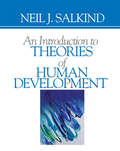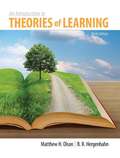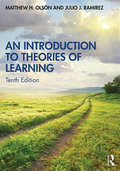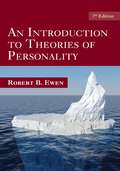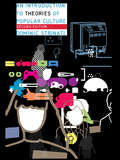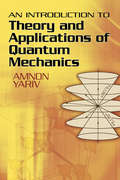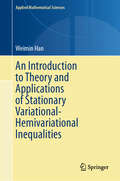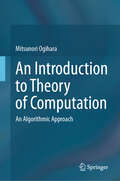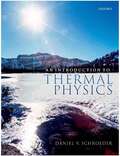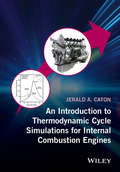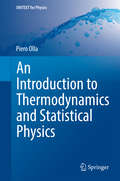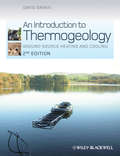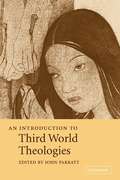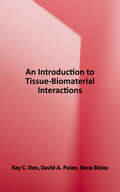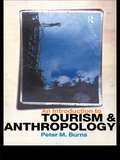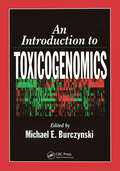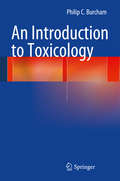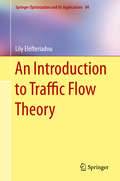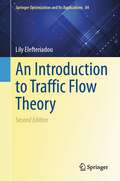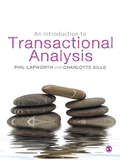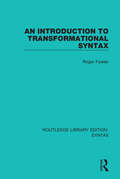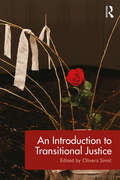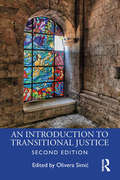- Table View
- List View
An Introduction to Theories of Human Development
by Neil J. Salkind"The book is well written and the theorists and their respective work are well-presented and clearly explained. . . . As a text dealing with the historical overview of major theorists and their work in human development over the last century or so, it is extremely strong and could be widely used in a variety of both undergraduate and graduate courses." —Ann C. Diver-Stamnes, Humboldt State University "In general, I found the websites and references listed at the end of each chapter to be very interesting and useful for taking students beyond what is in the text." —Jane Ledingham, University of Ottawa "A fine choice for a classic theories course, and I believe that the level of presentation would be appropriate for advanced undergraduate or graduate students. . . . The up-to-date web sites at the end of each section are a definite plus. The choice of sites is excellent." —Cosby Steele Rogers, Virginia Tech An Introduction to Theories of Human Development examines the development process, looking at the series of changes that occur as a result of an interaction between biological and environmental factors. Why might our behavior as an adult be so different from when we were infants? Why and how does one stage of development follow the next? Are the changes that we experience abrupt in nature or smooth and predictable? Author Neil J. Salkind reflects on such critical questions to help readers understand what happens along the way as one develops from infancy through later life. This book provides a comprehensive view of the primary theoretical models of human development including those from the biological, psychoanalytic, behavioral, and cognitive developmental perspectives. Along with a brief discussion of a historical background for each of these approaches, An Introduction to Theories of Human Development examines the application of these theories to various aspects of human development, such as the effectiveness of early intervention, individual differences, adolescence, and sociobiology. Features of this text: A final, integrative chapter compares the various theories presented in the book using Murry Sidman′s model of six criteria for judging a theory to help develop students′ skills for critically assessing theory. Classic approaches to understanding human behavior across the lifespan are also examined. Pedagogical features such as chapter opening quotes, boxed highlights, key terms, a glossary, and websites for further reading enhance student understanding of everyday human behavior.An Introduction to Theories of Human Development is an accessible text for advanced undergraduate students in the social and behavioral sciences including such fields as psychology, education, human services, nursing, sociology, social welfare, and human development and family studies.
An Introduction to Theories of Learning
by B. R. Hergenhahn Matthew H. OlsonDefines learning and shows how the learning process is studied. Clearly written and user-friendly, Introduction to the Theories of Learning places learning in its historical perspective and provides appreciation for the figures and theories that have shaped 100 years of learning theory research. The 9th edition has been updated with the most current research in the field. Learning Goals Upon completing this book, readers should be able to: Define learning and show how the learning process is studied Place learning theory in historical perspective Present essential features of the major theories of learning with implications for educational practice. <P><P><i>Advisory: Bookshare has learned that this book offers only partial accessibility. We have kept it in the collection because it is useful for some of our members. Benetech is actively working on projects to improve accessibility issues such as these.</i>
An Introduction to Theories of Learning
by Matthew H. Olson Julio J. RamirezSince its first edition, An Introduction to Theories of Learning has provided a uniquely sweeping review of the major learning theories from the 20th century that profoundly influenced the field of psychology. In this tenth edition, the authors present further experimental evidence that tests many of the fundamental ideas presented in these classic theories, as well as explore many of the advances in psychological science and neuroscience that have yielded greater insight into the processes that underlie learning in human beings and animals. The four main goals of this text are to define learning and to show how the learning process is studied (Chapters 1 and 2), to place learning theory in historical perspective (Chapter 3), and to present essential features of the major theories of learning with implications for educational practices (Chapters 4 through 16). The authors retained the best features of earlier editions while making revisions that reflect current research and scholarship, including coverage of active learning and the testing effect, information for problem solving in ravens, data illustrating the neurobiological basis of the cognitive map and spatial learning, new research on brain plasticity and its role in learning as well as the impact of poverty on brain and cognitive development, and new evidence that challenges the notion of learning styles. Complete with chapter summaries, discussion questions, glossary, and online resources for instructors, this text is essential reading for theories of learning and applied cognitive psychology courses.
An Introduction to Theories of Personality: 7th Edition
by Robert B. Ewen Robert Ewen BThis 7th Edition helps students unravel the mysteries of human behavior through its highly readable introduction to the ideas of the most significant personality theorists. Engaging biographical sketches begin each chapter, and unique capsule summaries help students review key concepts. Theories come alive through the inclusion of quotations from the theorists’ writings and numerous applications such as dream interpretation, psychopathology, and psychotherapy. Significant changes in the 7th edition include an extended discussion of the practical applications of personality theory, with an emphasis on guidelines that can help people increase their self-knowledge, make better decisions, and live more fulfilling lives. Fictionalized but true-to-life examples illustrating the perils of inadequate self-knowledge include college students, parents, terrorists, business executives, and politicians, while other examples show the positive outcomes that can result from a better understanding of one’s unconscious. This 7th edition also includes a more extensive discussion of how a lack of self-understanding caused difficulties for such noted theorists as Freud and Erikson, and a new section that explains how behavior can be strongly influenced by the situation as well as by one’s personality. Finally, a new interactive web site provides practice test questions and other topics of interest.
An Introduction to Theories of Popular Culture
by Dominic StrinatiAn Introduction to Theories of Popular Culture is widely recognized as an immensely useful textbook for students taking courses in the major theories of popular culture. Strinati provides a critical assessment of the ways in which these theories have tried to understand and evaluate popular culture in modern societies. Among the theories and ideas the book introduces are: mann culture, the Frankfurt School and the culture industry, semiology and structuralism, Marxism, feminism, postmodernism and cultural populism. This new edition provides fresh material on Marxism and feminism, while a new final chapter assesses the significance of the theories explained in the book.
An Introduction to Theory and Applications of Quantum Mechanics (Dover Books on Physics)
by Amnon YarivBased on a California Institute of Technology course, this outstanding introduction to formal quantum mechanics is geared toward advanced undergraduates in applied physics. The text addresses not only the basic formalism and related phenomena but also takes students a step further to a consideration of generic and important applications. The treatment's exploration of a wide range of topics culminates in two eminently practical subjects, the semiconductor transistor and the laser. Subjects include operators, Eigenvalue problems, the harmonic oscillator, angular momentum, matrix formulation of quantum mechanics, perturbation theory, the interaction of electromagnetic radiation with atomic systems, and absorption and dispersion of radiation in atomic media.Additional topics include laser oscillation, quantum statistics, applications of the statistical distribution laws, the interaction of electrons and nuclei with magnetic fields, and charge transport in semiconductors. Each chapter concludes with a set of problems.
An Introduction to Theory and Applications of Stationary Variational-Hemivariational Inequalities (Applied Mathematical Sciences #220)
by Weimin HanThis book offers a comprehensive and accessible introduction to the mathematical theory of stationary Variational-Hemivariational Inequalities (VHIs), a rapidly growing area of research with significant applications in science and engineering. Unlike traditional approaches that rely heavily on abstract inclusion results for pseudomonotone operators, this work presents a more user-friendly method grounded in basic Functional Analysis. VHIs include variational inequalities and hemivariational inequalities as special cases. The book systematically categorizes and names different VHIs, making it easier for readers to understand the specific problems being addressed. Designed for graduate students and researchers in mathematics, physical sciences, and engineering, this monograph not only provides a concise review of essential materials in Sobolev spaces, convex analysis, and nonsmooth analysis but also delves into applications in contact and fluid mechanics. Through detailed explanations and practical examples, the book bridges the gap between theory and practice, making the complex subject of VHIs more approachable. By focusing on the well-posedness of various forms of VHIs and extending the analysis to include mixed VHIs for the Stokes and Navier-Stokes equations, this book serves as an essential resource for anyone interested in the modeling, analysis, numerical solutions, and real-world applications of VHIs.
An Introduction to Theory of Computation: An Algorithmic Approach
by Mitsunori OgiharaThis textbook aims to provide a comprehensive introduction to the theory of computation for upper-level undergraduate students and first-year graduate students in computer science and related disciplines. It covers a wide range of foundational topics essential for understanding the principles and applications of computation. The book begins with regular languages, exploring finite automata, nondeterministic finite automata, regular expressions, and the equivalence among these apparatuses. It explores state minimization and the Myhill-Nerode Theorem, offering techniques such as pumping lemmas to identify non-regular languages and using the Myhill-Nerode Theorem for non-regularity proofs. Additionally, the closure properties of regular languages are examined. Context-free languages are another focal point, where the text discusses context-free grammars, Chomsky normal form grammars, pushdown automata, and their equivalences. The book includes pumping lemmas and closure properties using CNF grammars and PDA analysis, as well as identifying non-context-free languages and understanding leftmost derivations. Turing machine models are thoroughly covered, with various models and simulations explained. The book outlines configurations, the Church-Turing Thesis, and differentiates between recursive and recursively enumerable languages. Decidability and undecidability are critical topics in the text, addressing decidable problems, diagonalization, the halting problem, and Rice’s Theorem. It also provides a characterization of decidability, discusses the Post Correspondence Problem, and examines the lower levels of the arithmetical hierarchy. The textbook also delves into computational complexity classes, defining time and space complexity classes, and presenting efficient simulations and hierarchy theorems, including the Hennie-Stearns Theorem. It includes examples of problems in P and NP, providing a clear understanding of these classifications. NP-completeness is explored in detail, covering SAT and 3SAT, canonical complete problems, and various NP-complete problems. The book extends to space complexity classes, discussing PSPACE complete problems, NL-complete problems, and proving that NL=coNL. Finally, the text ventures beyond NP-completeness, discussing Ladner’s construction of non-NPC sets, randomized complexity classes, and concepts such as BPP and the polynomial hierarchy. It also examines polynomial size circuits, providing a comprehensive view of the landscape of computational complexity.
An Introduction to Thermal Physics
by Daniel SchroederThermal physics deals with collections of large numbers of particles - typically 10 to the 23rd power or so. Examples include the air in a balloon, the water in a lake, the electrons in a chunk of metal, and the photons given off by the sun. We can't possibly follow every detail of the motions of so many particles. So in thermal physics we assume that these motions are random, and we use the laws of probability to predict how the material as a whole ought to behave. Alternatively, we can measure the bulk properties of a material, and from these infer something about the particles it is made of. This book will give you a working understanding of thermal physics, assuming that you have already studied introductory physics and calculus. You will learn to apply the general laws of energy and entropy to engines, refrigerators, chemical reactions, phase transformations, and mixtures. You will also learn to use basic quantum physics and powerful statistical methods to predict in detail how temperature affects molecular speeds, vibrations of solids, electrical and magnetic behaviors, emission of light, and exotic low-temperature phenomena. The problems and worked examples explore applications not just within physics but also to engineering, chemistry, biology, geology, atmospheric science, astrophysics, cosmology, and everyday life.
An Introduction to Thermodynamic Cycle Simulations for Internal Combustion Engines
by Jerald A. CatonThis book provides an introduction to basic thermodynamic engine cycle simulations, and provides a substantial set of results. Key features includes comprehensive and detailed documentation of the mathematical foundations and solutions required for thermodynamic engine cycle simulations. The book includes a thorough presentation of results based on the second law of thermodynamics as well as results for advanced, high efficiency engines. Case studies that illustrate the use of engine cycle simulations are also provided.
An Introduction to Thermodynamics and Statistical Mechanics
by Keith StoweThis introductory textbook for standard undergraduate courses in thermodynamics has been completely rewritten. Starting with an overview of important quantum behaviours, the book teaches students how to calculate probabilities, in order to provide a firm foundation for later chapters. It introduces the ideas of classical thermodynamics and explores them both in general and as they are applied to specific processes and interactions. The remainder of the book deals with statistical mechanics - the study of small systems interacting with huge reservoirs. The changes to this 2007 second edition have been made after more than 10 years classroom testing and student feedback. Each topic ends with a boxed summary of ideas and results, and every chapter contains numerous homework problems, covering a broad range of difficulties. Answers are given to odd numbered problems, and solutions to even problems are available to instructors at www. cambridge. org/9780521865579.
An Introduction to Thermodynamics and Statistical Physics (UNITEXT for Physics)
by Piero OllaThis textbook offers an advanced undergraduate or initial graduate level introduction to topics such as kinetic theory, equilibrium statistical mechanics and the theory of fluctuations from a modern perspective. The aim is to provide the reader with the necessary tools of probability theory and thermodynamics (especially the thermodynamic potentials) to enable subsequent study at advanced graduate level. At the same time, the book offers a bird's eye view on arguments that are often disregarded in the main curriculum courses. Further features include a focus on the interdisciplinary nature of the subject and in-depth discussion of alternative interpretations of the concept of entropy. While some familiarity with basic concepts of thermodynamics and probability theory is assumed, this does not extend beyond what is commonly obtained in basic undergraduate curriculum courses.
An Introduction to Thermogeology
by David BanksThis authoritative guide provides a basis for understanding the emerging technology of ground source heating and cooling. It equips engineers, geologists, architects, planners and regulators with the fundamental skills needed to manipulate the ground's huge capacity to store, supply and receive heat, and to implement technologies (such as heat pumps) to exploit that capacity for space heating and cooling.The author has geared the book towards understanding ground source heating and cooling from the ground side (the geological aspects), rather than solely the building aspects. He explains the science behind thermogeology and offers practical guidance on different design options.An Introduction to Thermogeology: ground source heating and cooling is aimed primarily at professionals whose skill areas impinge on the emerging technology of ground source heating and cooling. They will be aware of the importance of the technology and wish to rapidly acquire fundamental theoretical understanding and design skills.This second edition has been thoroughly updated and expanded to cover new technical developments and now includes end-of-chapter study questions to test the reader's understanding.
An Introduction to Third World Theologies
by John ParrattProviding the first overview of the main trends and contributions to Christian thought of Third World theologies, this book gathers essays from experts on Latin America, India, East Asia, West and East Africa, Southern Africa and the Caribbean. It analyzes the common context of the Third World theologies in their experience of colonialism and Western missions, and suggests that they provide different perspectives on what it means to be a Christian in today's world.
An Introduction to Tides
by Theo GerkemaThis textbook is a self-contained introduction to tides that will be useful for courses on tides in oceans and coastal seas at an advanced undergraduate and postgraduate level, and will also serve as the go-to book for researchers and coastal engineers needing information about tides. The material covered includes: a derivation of the tide-generating potential; a systematic overview of the main lunar periodicities; an intuitive explanation of the origin of the main tidal constituents; basic wave models for tidal propagation (e.g. Kelvin waves, the Taylor problem); shallow-water constituents; co-oscillation and resonance; frictional and radiation damping; the vertical structure of tidal currents; and a separate chapter on internal tides, which deals with ocean stratification, propagation of internal tides (vertical modes and characteristics) and their generation. Exercises are provided in each chapter.
An Introduction to Tissue-Biomaterial Interactions
by Rena Bizios David A. Puleo Kay C. DeeThis book acquaints an undergraduate audience with the fundamental biological processes that influence these sophisticated, cutting-edge procedures. Chapters one through three provide more detail about the molecular-level events that happen at the tissue-implant interface, while chapters four through ten explore selected material, biological, and physiological consequences of these events. The importance of the body’s wound-healing response is emphasized throughout. Specific topics covered include: Structure and properties of biomaterials - Proteins - Protein-surface interactions - Blood-biomaterial interactions - Inflammation and infection - The immune system - Biomaterial responses to implantation - Biomaterial surface engineering - Intimal hyperplasia and osseointegration as examples of tissue-biomaterial interactions The text also provides extensive coverage of the three pertinent interfaces between the body and the biomaterial, between the body and the living cells, and between the cells and the biomaterial that are critical in the development of tissue-engineered products that incorporate living cells within a biomaterial matrix. Ideal for a one-semester, biomedical engineering course, An Introduction to Tissue-Biomaterial Interactions provides a solid framework for understanding today’s and tomorrow’s implantable biomedical devices.
An Introduction to Tourism and Anthropology
by Peter BurnsThis introductory text explains how anthropology is integral to the study of tourism dynamics. Starting with an overview of the development of anthropology as a social science, the author uses a wealth of international examples, including the UK, USA and Australia, to bring practical relevance to complex theories. With its lucid writing style, summaries, sample questions and suggestions for further reading, this book will be an invaluable teaching resource in this area.
An Introduction to Toxicogenomics
by Michael E. BurczynskiSince the advent of cDNA microarrays, oligonucleotide array technology, and gene chip analysis, genomics has revolutionized the entire field of biomedical research. A byproduct of this revolution, toxicogenomics is a fast-rising star within toxicological analysis. Gathering together leading authors and scientists at the forefront of the field, An Introduction to Toxicogenomics provides a comprehensive overview of this new discipline. With a focus on toxicology, it introduces the basic principles of microarray/oligonucleotide array-based genomic analysis and explains how it fits into the field of biomedical research. These discussions provide an overview to the actual mechanics of the analyses themselves and offer insights on handling and quality control. Then the book features an important section on the basics of data analysis and clustering methods such as genetic algorithms. Finally, it covers the application of expression profiling in the field of toxicology and addresses the two fundamental types of analysis in detail, with sections dedicated to both mechanistic and predictive studies. Although toxicogenomics promises fast, efficient techniques and information-rich data, much of its potential remains untapped. An Introduction to Toxicogenomics consolidates the concepts underlying the field to provide a solid foundation from which to begin your research endeavors.
An Introduction to Toxicology
by Philip C. BurchamThis book provides a readable introduction to modern toxicology with a particular focus on the mechanisms underlying the induction of toxicity by foreign substances. Since bioactivation is central to many toxic syndromes, special interest is devoted to chemicals that undergo conversion to toxic metabolites that induce toxic effects as diverse as cancer, birth defects and organ injury. The molecular consequences accompanying damage to cellular DNA and proteins is explored together with the relevance of toxicological paradigms to human diseases caused by alcohol and tobacco. The discipline of toxicology has developed rapidly since the thalidomide disaster in the 1960's as scientists worldwide seek to understand the adverse health effects of human medicines, environmental pollutants, consumer chemicals and industrial reagents. An Introduction to Toxicology is intended to supplement the recommended reading list of undergraduate and graduate programs in toxicology and pharmacology as an enjoyable, accessible primer with illustrations that "unpack" the concepts being discussed in the text.
An Introduction to Traffic Flow Theory (Springer Optimization and Its Applications #84)
by Lily ElefteriadouThis text provides a comprehensive and concise treatment of the topic of traffic flow theory and includes several topics relevant to today's highway transportation system. It provides the fundamental principles of traffic flow theory as well as applications of those principles for evaluating specific types of facilities (freeways, intersections, etc. ). Newer concepts of Intelligent transportation systems (ITS) and their potential impact on traffic flow are discussed. State-of-the-art in traffic flow research and microscopic traffic analysis and traffic simulation have significantly advanced and are also discussed in this text. Real world examples and useful problem sets complement each chapter. This textbook is meant for use in advanced undergraduate/graduate level courses in traffic flow theory with prerequisites including two semesters of calculus, statistics, and an introductory course in transportation. The text would also be of interest to transportation professionals as a refresher in traffic flow theory, or as a reference. Students and engineers of diverse backgrounds will find this text accessible and applicable to today's traffic issues.
An Introduction to Traffic Flow Theory (Springer Optimization and Its Applications #84)
by Lily ElefteriadouThis second edition of An Introduction to Traffic Flow Theory adds new material in several chapters related to advanced technologies including autonomy, the use of sensors and communications, and particularly congestion mitigation solutions that leverage connected and autonomous vehicles (CAVs). It also includes a new chapter that briefly outlines several mathematical analysis techniques commonly used in traffic flow theory, aiming to introduce students to some of the most frequently used tools available for traffic operational-related analysis. This new edition also includes several updates related to the most recent versions of the Highway Capacity Manual and the Green Book. This textbook is meant for use in advanced undergraduate/graduate level courses in traffic flow theory with prerequisites including two semesters of calculus, statistics, and an introductory course in transportation. The text would also be of interest to transportation professionals as a refresherin traffic flow theory or as a reference. Students and engineers of diverse backgrounds will find this text accessible and applicable to today’s traffic issues.This text provides a comprehensive and concise treatment of the topic of traffic flow theory and includes several topics relevant to today’s highway transportation system. It provides the fundamental principles of traffic flow theory as well as applications of those principles for evaluating specific types of facilities (freeways, intersections, etc.). Newer concepts of Intelligent transportation systems (ITS) and their potential impact on traffic flow are discussed. State-of-the-art traffic flow research, microscopic traffic analysis, and traffic simulation have significantly advanced and are also discussed in this text. Real-world examples and useful problem sets complement each chapter.
An Introduction to Transactional Analysis: Helping People Change
by Charlotte Sills Mr Phil LapworthThis thoroughly revised edition of Transactional Analysis Counselling introduces the theory and practice of TA - which integrates cognitive behavioural and psychodynamic theories within a humanistic philosophy - from a unique relational perspective. While most TA books focus on one field, this approach demonstrates the benefits of TA across a wide variety of helping settings, business and management, education and coaching as well as counselling. Case studies from a variety of contexts bring TA to life for trainees in any of these disciplines, and the accessible, engaging writing style makes difficult concepts understandable for undergraduates and postgraduates alike. Bringing their book into the twenty-first century, expert authors Phil Lapworth and Charlotte Sills provide a brief history of TA followed by individual chapters on the concepts and techniques used. Each chapter is devoted to one concept and includes a detailed definition and description, and suggestions for application in practice. Exercises for student, practitioner and client, boxed summaries, diagrams, checklists and sources of further reading make this the ideal text for use in training. This book is an essential companion for those embarking on specialist TA courses or studying TA as part of wider training, while those who want simply to integrate TA into their work with people can dip into it as suits their needs.
An Introduction to Transformational Syntax (Routledge Library Editions: Syntax #9)
by Roger FowlerTransformational syntax is an analytic technique of grammatical description which has exciting psychological and philosophical ramifications inspiring creative research into the conceptual powers and behaviour of man. In this book, first published in 1971, the author suggests that the techniques of the classical period (1964-66) of transformational syntax provide the securest foundation for syntactic analysis, and are indispensable if students are to understand recent changes to the analytical technique. This title will be of interest to students of language and linguistics.
An Introduction to Transitional Justice
by Olivera SimicAn Introduction to Transitional Justice provides the first comprehensive overview of transitional justice judicial and non-judicial measures implemented by societies to redress legacies of massive human rights abuse. Written by some of the leading experts in the field it takes a broad, interdisciplinary approach to the subject, addressing the dominant transitional justice mechanisms as well as key themes and challenges faced by scholars and practitioners. Using a wide historic and geographic range of case studies to illustrate key concepts and debates, and featuring discussion questions and suggestions for further reading, this is an essential introduction to the subject for students.
An Introduction to Transitional Justice
by Olivera SimićThe Second Edition of An Introduction to Transitional Justice provides a comprehensive overview of transitional justice judicial and non-judicial measures implemented by societies to redress legacies of massive human rights abuse. Written by some of the leading experts in the field, it takes a broad, interdisciplinary approach to the subject, addressing the dominant transitional justice mechanisms as well as key themes and challenges faced by scholars and practitioners. Using a wide historic and geographic range of case studies to illustrate key concepts and debates, and featuring discussion questions and suggestions for further reading, this is an essential introduction to the subject for students.
